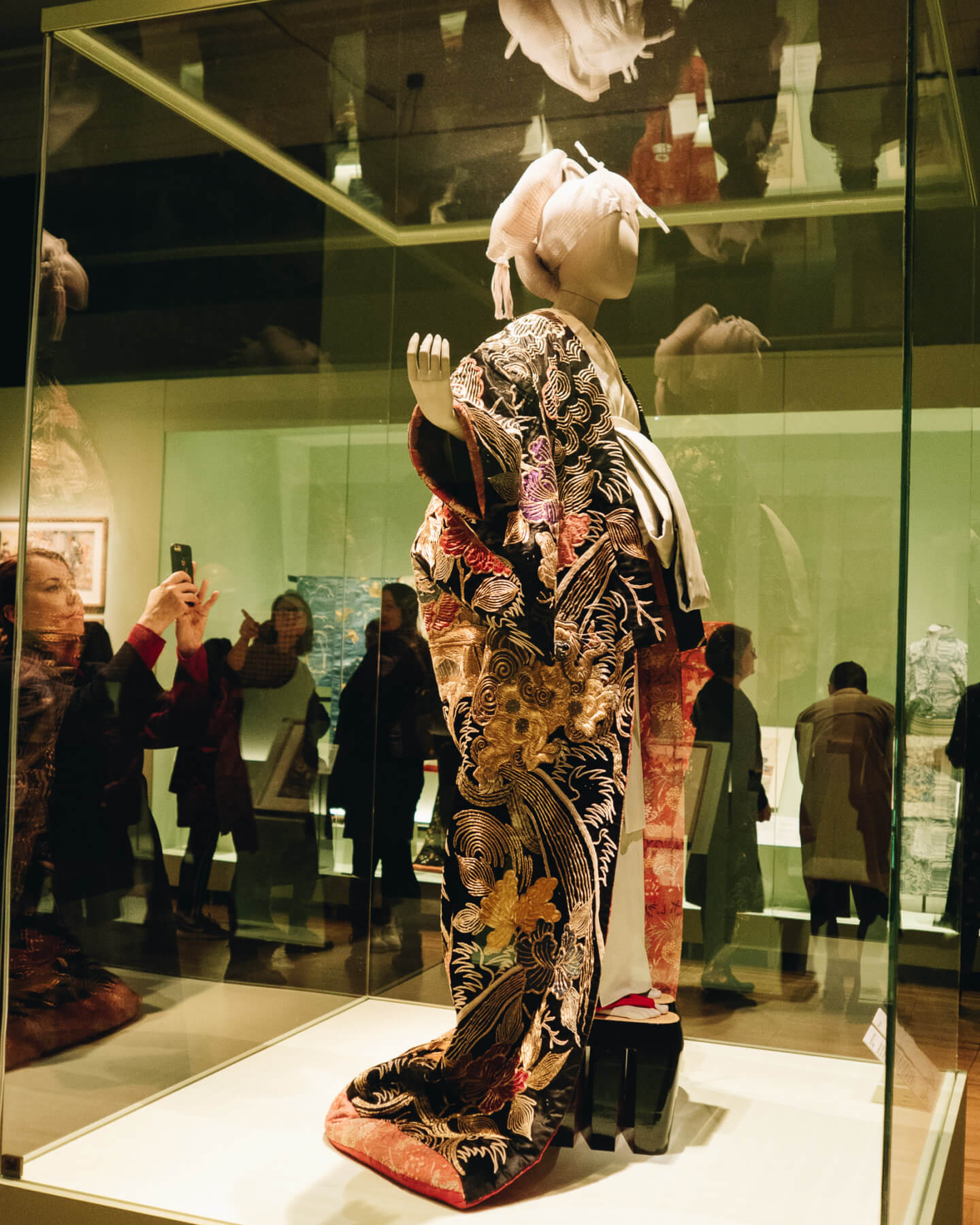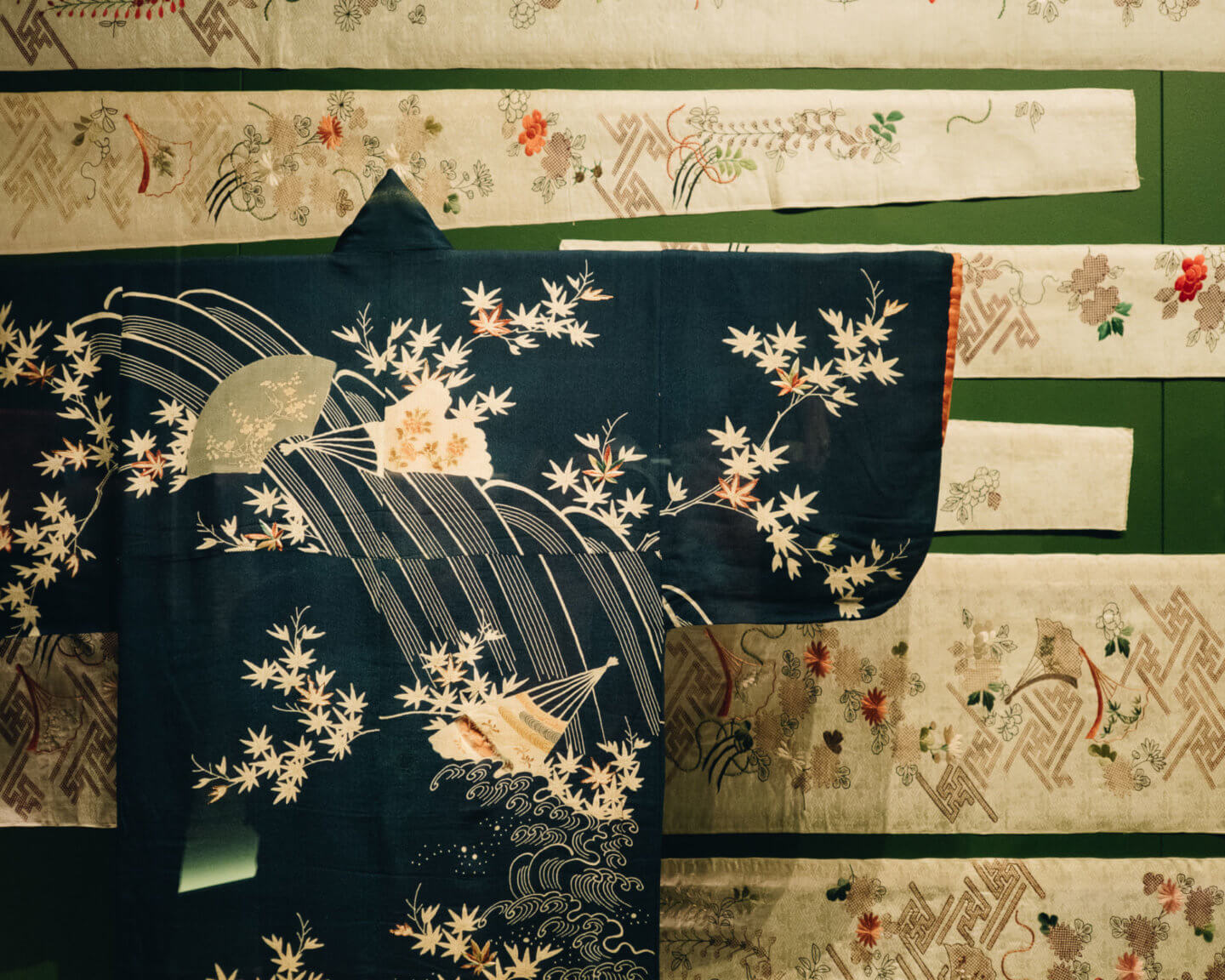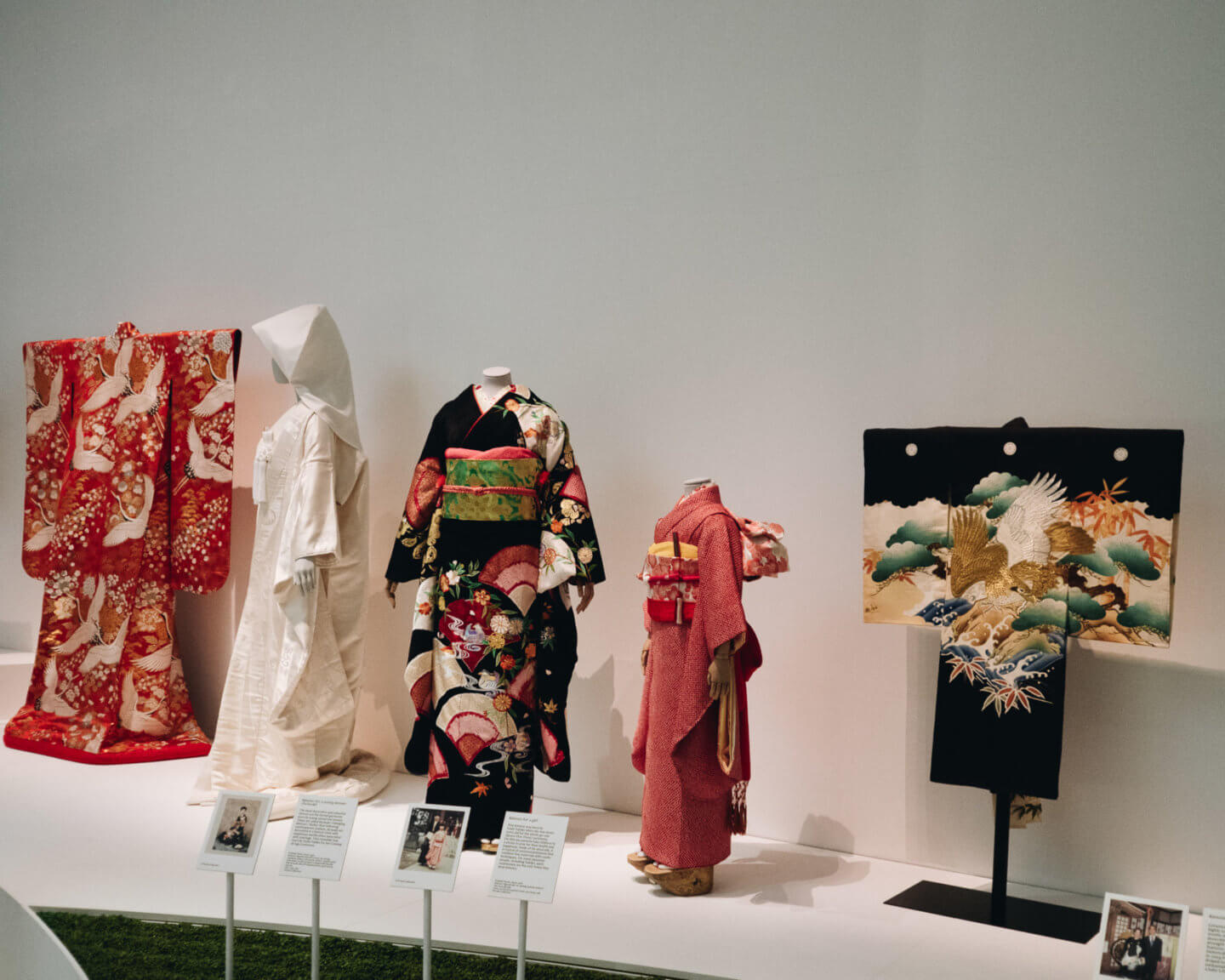
I had been looking forward to checking out this special exhibition about Kimono since the V&A first announced it. During the opening weekend, I popped along for a visit to find lots of people curiously working their way through galleries packed to the brim with a whole host of beautiful Kimono. In this sense, I couldn’t have been happier to see so many people turning out for a Japan-themed exhibition.
ロンドンの博物館「ビクトリア&アルバート (V&A)」で着物の企画展示が開催されると聞いてから、この日をずっと楽しみにしていました。2020年2月末からスタートした展示に、オープン直後の週末に行ってきました。空間いっぱいに広がる美しい着物の展示。オーディエンスであふれた空間で、日本に関する展示がこんなにも注目を浴びるなんて嬉しいと感じました。

Overall, the gallery space was not bad when viewed as a kind of fashion exhibit; all the kimono on display were very beautiful. However, I was left with somewhat mixed feelings in my mind. As a Japanese woman who loves to dress in Kimono for special occasions, and who grew up with my parents wearing Kimono quite often for these occasions, I felt the core concept of this exhibition did not fully express the depth of Kimono as a cultural artifact, or the significance of Kimono in contemporary Japan today.
着物はどれも本当に美しくて、「ファッション」の展示であると捉えるのなら、とても良かった展示です。でも、残念ながら、私にとっては心から満足できる内容ではありませんでした。着物を着ることが好きな日本人の一人として、また、新年には着物を着る父や茶道で和装をする母という、着物を着る機会が多い両親を持つ日本人として育った私にとって、今回の展示のコンセプトに共感できませんでした。それは、日本人にとって「文化」としての着物の大切さや、現代の日本における着物の重要性について言及が少ないと感じたから。

The exhibition was designed to follow the development of Kimono in chronological order, starting from the Edo period and covering how they were created and sold during this time.
展示は、着物にまつわる歴史を江戸時代からさかのぼっていきます。どのように制作され、販売されていたのか。

Artisans of beautiful and flamboyant embroidered Kimonos developed their trade through the creation of Kimono for military elites to show off their status. This section displayed especially gorgeous garments with lots of references to Geisha and Oiran.
また、豪華な着物がエリート層の豊かさの象徴であったことも解説されています。芸者や花魁の衣装に触れながら、特にゴージャスな着物が展示されていました。

The surprising instance of Western / European influences on Kimono made for an especially interesting section. There were Juban (under-kimono) made from European floral fabrics on display.
興味深かったのは、西洋文化の影響について。ヨーロッパの花柄の布地を用いた襦袢も展示されていました!

The last section showcased Kimono on the global stage, from lots of famous designers’ Kimono works, to Kimono-inspired costumes from films such as Star Wars and Memoirs of a Geisha. You could even see the Kimono from Bjork’s iconic album cover.
最後の展示フロアは、グローバルな世界を舞台に活躍する着物について。有名デザイナーの着物や、着物にインスピレーションを得たスタイル、スターウォーズの映画に使われた衣装や、アーティストのビョークのアルバムジャケットに使用された衣装も展示されていました。

Despite there being nearly 300 art pieces on display – all incredibly beautiful and amazing – I felt it was a shame that there was none or very minimal reference to any individuals who wore Kimono in daily life, how to wear Kimono, when to wear kimono, the difference between Kosode (short sleeves) and Furisode (long sleeves). The exhibition came across as voiceless and generic.
300以上の着物が展示されているという今回の着物展、どれも素晴らしくて、写真を撮る手が止まりません…でも、この着物が、日本の日常生活や、現代の日本でどのように、どんな時に着られているのか、また小袖や振袖がどう違うのか。そういった日本人なら当たり前に知っているような説明は一切無く、結局「着物」が何なのか、根本的な言葉が見つかりませんでした。

I rather felt that Kimono had been made into something normal people would not have any connection to. There was a tiny section displaying a Kimono used for weddings, and family photo snapshots, but it was poorly explained and did not fit well into the exhibition’s overall narrative. Tacked on at the end, it almost felt out of place.
むしろ、この展示では着物は一般人には関係のないもの、すごく遠い存在のように感じられました。小さなセクションで、結婚式や家族写真で着物を着ている様子が再現されていましたが、ここにどんな家庭の、どんな事情で着物を着るのかというような、ストーリーが全く説明されておらず。突然ひょっこりと地味めな着物が登場するので、なんだか場違いにさえ見えました。

Kimono as a fashion is a continually evolving piece of iconography. I understand this as the theme the exhibition clearly wanted to sell. But at the same time, Kimono is also a form of traditional clothing that Japanese people nowadays still choose to wear for important occasions. Without any reference to the cultural significance of Kimono in Japanese culture today, this exhibition made me feel upset, by seeming to position Kimono almost purely as a fashion piece. Presented in isolation in this manner, I felt no real respect towards its rich history (or its continuing relevance to contemporary Japanese society).
着物は、たしかに進化を続けるファッションアイコンです。それはこの展示でも強く打ち出されたメインテーマで、着物の持つ強いアピール力に、私も納得します。しかし、それと同時に着物は日本の大切な伝統衣装で、日本人の一生の節目節目に現代でも現れる、大切な文化の一部です。そんな、現代の日本の文化における着物の重要性について、ほとんど触れないような展示のストーリーに、私はがっかりしてしまいました。

What about placing the complexities of the kimono in relation to contemporary news coverage? For example, the recent story of the thousands of girls’ let down in advance of their coming-of-age ceremonies when the store they were renting their Kimono from suddenly went bankrupt.
着物は決して昔の人やファッションショーの中の衣装だけではないはず。昨今は着物の着付け業者が夜逃げし、成人式のために振袖を予約していた女の子が涙を流す様子が大きなニュースになっていました。
In general, I thought the V&A could have done much better – their recent Mary Quant Exhibition being a fine example – by explaining more about the socio-historical background of the Kimono; how these clothes had been both influenced by, and impacted on, society, as well as how people over the years have understood and enjoyed its unique beauty as both a form of clothing and artform.
今回の展示、もっといいものができたのでは?という想いが拭えません。以前同じV&Aで開催されていた「マリークヮント」の企画展示はとても良かった。それは、社会・歴史的な背景にもっと焦点を当てつつ、この服が何に影響され、そして社会にどんな影響を与えたのか、また人々はそれをどう受け止め、そのファッションをどんなふうに楽しんだのか…教科書のように一方的に歴史やアートを並べるだけでなく、ブランドを愛した人々の声まで伝わってくる展示でした。
‘Cool Japan’ , ‘Quirky Japan,’ Samurai, Geisha and sushi…. I see many aspects of ‘Japan’ being appreciated by global audiences and it is great to see the concept of ‘Japan’ being made famous and popular worldwide. But at the same time, I am a little overwhelmed by many of the misconceptions regarding them (Eg. ‘Geisha’ are not prostitutes! They are professionally trained traditional art performers.) and the gap between this imagined ‘Japan’ and the real life, contemporary Japan I was experiencing every day while I lived there.
「クールジャパン」とか侍とかゲイシャに寿司とか….「日本」というコンセプトが世界でも有名で人気なのは嬉しいこと。でも、その中にある間違いや、現代日本との乖離に目が回る思いがあります。
In the exhibition gift shop I spotted a Kimono with a family crest on it that had been made into a ‘Kimono dressing gown’ without any reference to what this Kimono was originally used for (black Kimono with a family crest are for formal occasions such as funerals and marriage)! I thought about how I would feel seeing a random person wearing a kimono gown with my family crest.
着物展のギフトショップには、黒紋付の着物が「キモノガウン」に作り替えられて売っていました。どんな着物なのかという説明書きもなく。人様の家紋が付いているとは知らず、クールな黒のキモノ!って言ってみているお客さんがいました。元はどんな着物なのか、背景を知った上で着るならアリかとは思うものの、なんとも複雑な気持ちになります。
Flashy Kimono from the Catwalk are certainly cool, but this is not the only way of viewing Kimono in contemporary Japan. Although I hesitated to write something slightly negative about this successful exhibition, I believe it is essential for the world to think more thoroughly about how to build a balanced narrative around something that is both traditional and constantly evolving (eg. what is the line between ‘inspiration’ and ‘cultural appropriation’). Likewise, I think it is important for Japanese people to be aware of how those abroad can tend to show off or celebrate an ‘extreme Japanese-ness’ that may not fully represent Japan in the context of current, everyday society.
かっこいい、美しい、ファッションショーの中の着物はたしかにステキ。でも、これだけが現代日本の「着物」ではないはず。大成功の展示に対してネガティブな意見を書くことに戸惑いはあったものの、伝統的かつ現在も進化を続けるアイコンについて語る際の、バランスやニュアンスは、日本に限らず、世界で熟慮されるべきテーマだと思います。(例えば、どこまでがインスピレーションやオマージュで、どこからが文化盗用なのでしょう)また、海外にいると、日本人は「日本らしさ」というものを押し出しがちですが、これは日本の、本来の日常とはちょっと違うのでは。何が正しいか、間違っているか、そういう答えを見つけるのが難しいテーマですが、この記事がそんなことを考えるきっかけになったら嬉しいです。
